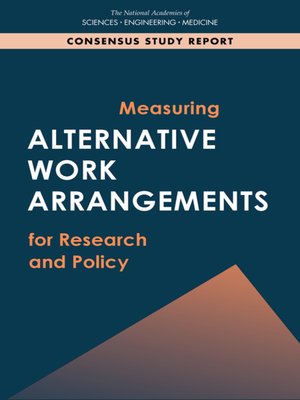Measuring Alternative Work Arrangements for Research and Policy
ebook
By National Academies of Sciences, Engineering, and Medicine

Sign up to save your library
With an OverDrive account, you can save your favorite libraries for at-a-glance information about availability. Find out more about OverDrive accounts.
Find this title in Libby, the library reading app by OverDrive.



Search for a digital library with this title
Title found at these libraries:
| Library Name | Distance |
|---|---|
| Loading... |
Business structures, employment relationships, job characteristics, and worker outcomes have changed in the United States over the last few decades—in some ways unpredictably. A high level of interest exists among policy makers and researchers in addressing concerns about the future of work in the United States. These concerns are heightened by the perceived fracturing of relationships between workers and employers, the loss of safety net protections and benefits to workers, the growing importance of access to skills and education as the impacts of new technologies and automation are felt, and the market-based pressure that companies face to produce short-term profits, sometimes at the expense of long-term value.
These issues, as well as related ones such as wage stagnation and job quality, are often associated with alternative work arrangements (AWAs)—which include independent-contractor and other nonemployee jobs, work through intermediaries such as temporary help agencies and other contract companies, and work with unpredictable schedules—although they also pertain to many standard jobs. A better understanding of the magnitude of and trends in AWAs, along with the implications for job quality, is needed to develop appropriate policies in response to the changing nature of work.
Measuring Alternative Work Arrangements for Research and Policy reviews the Contigent Worker Supplement (CWS) of the Current Population Survey (CPS) for the Bureau of Labor Statistics (BLS) in the U.S. Department of Labor. The CWS provides key measures of temporary (contingent) work, alternative work arrangements, and the "gig" economy. Disagreements, however, exist among researchers, policy makers, and other stakeholders about the definitions and measures of these concepts and priorities for future data collection. The report also reviews measures of employment, earnings, and worker well-being in temporary and alternative work arrangements that can be estimated using household survey data, such as those generated by the CWS, as well as measures that can be produced using administrative, commercial, and combined data sources. The comparative advantages and complementarities of different data sources will be assessed, as well as methodological issues underpinning BLS's measurement objectives.







